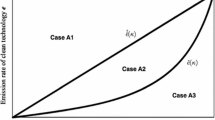Abstract
We consider one polluting industry in an open economy. The national government implements a policy of industrial pollution control, by inducing appropriate technological innovation to reduce toxic emissions. The emission-reducing innovations are developed through firm-specific costly investments. Under different hypotheses on market structure (perfect competition, Bertrand and Cournot oligopoly), international competition forces the national government to subsidize innovation. The appropriate subsidy scheme varies according to the information available to the government and according to market structure. If information is asymmetric, the subsidy must include the information premium necessary to separate different types of firms.
Similar content being viewed by others
References
Baron, D. (1985), ‘Regulation of Prices and Pollution under Incomplete Information’, Journal of Public Economics 28, 211–232.
Baron, D. and D.Besanko (1984), ‘Regulation and Information in a Continuing Relationship’, Information Economics and Policy 1, 447–470.
Baumol, W. and W.Oates (1985), The Theory of Environmental Policy, Cambridge, CUP.
Conrad, K. (1987), ‘An Incentive Scheme for Optimal Pricing and Environmental Protection’, Journal of Institutional and Theoretical Economics 143, 402–421.
Downing, P. B. and L. J.White (1986), ‘Innovation in Pollution Control’, Journal of Environmental Economics and Managment 13, 18–29.
Guesnerie, R. and J. J.Laffont (1984), ‘A Complete Solution to a Class of Principal-Agent Problems with an Application to the Control of a Self-Managed Firm’, Journal of Public Economics 25, 329–369.
Laffont, J. J. and J.Tirole (1986), ‘Using Cost Observation to Regulate Firms’, Journal of Political Economy 94, 614–641.
Laffont, J. J. and J.Tirole (1988), ‘The Dynamics of Incentive Contracts’, Econometrica 56, 1153–1175.
Milliman, S. R. and R.Prince (1989), ‘Firms' Incentives to Promote Technological Change in Pollution Control’, Journal of Environmental Economics and Management 17, 247–265.
Picard, P. (1987), ‘On the Design of Incentive Schemes under Moral Hazard and Adverse Selection’, Journal of Public Economics 33, 305–331.
Siebert, H. (1981), Economics of the Environment, Lexington, MA.
Author information
Authors and Affiliations
Rights and permissions
About this article
Cite this article
Carraro, C., Siniscalco, D. Environmental innovation policy and international competition. Environmental and Resource Economics 2, 183–200 (1992). https://doi.org/10.1007/BF00338242
Issue Date:
DOI: https://doi.org/10.1007/BF00338242




